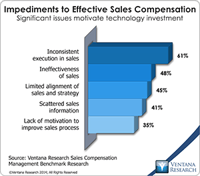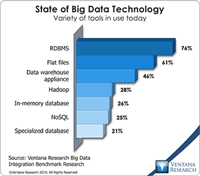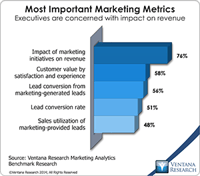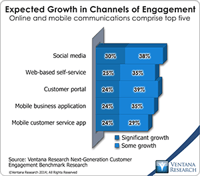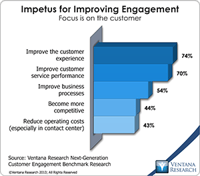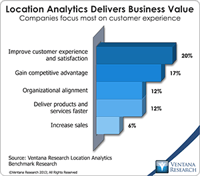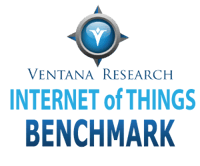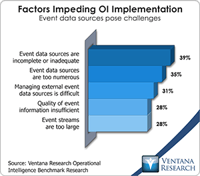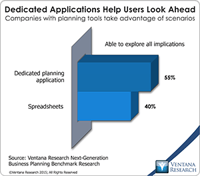I recently attended .conf2016, Splunk’s seventh annual user conference. Splunk created the market for analyzing machine data (shorthand for machine-generated data), which consists of log files and event data from various types of systems and devices. Our big data analytics benchmark research shows that these are two of the most common sources of big data that organizations analyze. This market has proven to be fertile ground for Splunk, growing steadily with revenues more than doubling over the...
Read More
Topics:
Machine Learning,
Splunk,
Analytics,
Machine data,
Operational Intelligence
Imagine how the third Monday in next January looks to leaders in the sales department. That’s the first day of the annual sales kickoff and the excitement level won’t get any higher. New products and services are in the works, lucrative customer contracts are up for renewal, alliance partners are in the house, and qualified opportunities are already flowing through your pipeline. The executive team is expecting big things from sales in the new year and has approved hiring additional people to...
Read More
Topics:
Sales,
Sales Performance,
Human Capital,
Human Capital Management,
Mobile Technology,
CRO,
Analytics,
Business Analytics,
Business Collaboration,
Business Performance,
Financial Performance,
Operational Intelligence
It’s part of my job to cover the ecosystem of Hadoop, the open source big data technology, but sometimes it makes my head spin. If this is not your primary job, how can you possibly keep up? I hope that a discussion of what I’ve found to be most important will help those who don’t have the time and energy to devote to this wide-ranging topic.
Read More
Topics:
Big Data,
Business Analytics,
Business Intelligence,
Information Management,
Operational Intelligence
It often seems to business-to-business (B2B) marketers as if the only people who understand them are other B2B marketers. They feel that salespeople don’t get what they do day-to-day, that friends and family don’t understand what they do for a living, and most of all that the executives to whom they report have no interest in what they do – that is, until the last day of the quarter. Then they require that B2B marketers deliver positive, lead-generating and revenue-producing results in reports...
Read More
Topics:
Big Data,
Sales Performance,
Operational Performance,
Analytics,
Business Analytics,
Business Collaboration,
Business Intelligence,
Business Performance,
Cloud Computing,
Operational Intelligence,
Hive9 Marketing Performance Management
In July Salesforce officially closed on its purchase of digital commerce platform provider Demandware for US$2.8 billion. Salesforce’s executives were interested in acquiring a digital commerce platform, and they claim that Demandware was routinely mentioned in their due diligence of the market. So out came Marc Benioff’s and Salesforce checkbook, and they paid. Handsomely. For that sizeable investment, Salesforce will add Demandware’s SaaS-delivered digital commerce capabilities to its...
Read More
Topics:
Social Media,
Mobile Technology,
Office of Finance,
Business Analytics,
Business Collaboration,
Business Intelligence,
Business Performance,
Cloud Computing,
Financial Performance,
Operational Intelligence,
Uncategorized,
Omnichannel, Commerce, Digital kDigital
Businesses and customers are ready for a new generation of digital commerce technology, but implementing it is challenged by significant barriers in two basic categories: technology commoditization and the lack of an IT and business framework for delivering great customer experiences. Regarding the first, for some companies making large IT purchases, the way an enterprise employs CAPEX and OPEX accounting practices to categorize spending on technology may be a deal-breaker when coupled with the...
Read More
Topics:
Sales Performance,
Social Media,
Mobile Technology,
Wearable Computing,
Customer Performance,
Business Analytics,
Business Collaboration,
Business Intelligence,
Business Performance,
Cloud Computing,
Operational Intelligence,
Uncategorized,
Mobile Marketing Digital Commerce
One aspect of living in downtown Chicago is that there’s always something going on. But as distasteful as the subject matter of certain local events can be, some proceedings can inspire perspectives on a number of topics. One that occurs to me is how the retail industry can apply the new generation of mobile and location-based technologies not only to shape the customer experience but even rescue it from challenging situations. On Nov. 30, 2015, the Chicago Tribune reported that the Black...
Read More
Topics:
Social Media,
Mobile Technology,
Wearable Computing,
Customer Performance,
Business Analytics,
Business Collaboration,
Business Intelligence,
Business Performance,
Cloud Computing,
Operational Intelligence,
Uncategorized,
Mobile, Marketing Location Communication
Enterprise messaging is the technology backbone of communications for applications and systems within and between organizations. Both its importance and its complexity are growing as organizations increasingly have to provide real-time responses to business customers and consumers as well as their own business professionals who support them and their internal supply chains. The variety of use cases for enterprise messaging also is growing rapidly, expanding to the Internet of Things (IoT)...
Read More
Topics:
Big Data,
Social Media,
Supply Chain Performance,
Enterprise messaging, Internet of Things, IoT, mid,
Mobile Technology,
Customer Performance,
Operational Performance,
Business Performance,
Cloud Computing,
Governance, Risk & Compliance (GRC),
Information Management,
Operational Intelligence,
Uncategorized,
Information Optimization
The emerging Internet of Things (IoT) is an extension of digital connectivity to devices and sensors in homes, businesses, vehicles and potentially almost anywhere. This innovation means that virtually any device can generate and transmit data about its operations – data to which analytics can be applied to facilitate monitoring and a range of automatic functions. To do these tasks IoT requires what Ventana Research calls operational intelligence (OI), a discipline that has evolved from the...
Read More
Topics:
Big Data,
Predictive Analytics,
Supply Chain Performance,
IOT, OperationalIntelligence, Real-time,
Operational Intelligence,
Uncategorized
I hope this title captures your attention; I’m trying to make a point about the chaos going on in managing and operating marketing. What marketing needs in 2016 is to manage and optimize its efforts in a more unified manner. This perspective kicks off a new series on the challenges for marketing to automate or execute tasks and manage toward maximum performance. We all know that the craft of marketing is in need of significant transformation, from the CMO throughout the entire marketing...
Read More
Topics:
Big Data,
Predictive Analytics,
Social Media,
Customer Performance,
Business Analytics,
Business Collaboration,
Business Intelligence,
Business Performance,
Cloud Computing,
Financial Performance,
Information Applications,
Operational Intelligence,
Uncategorized,
CMO,
Information Optimization,
Sales Performance Management (SPM)

